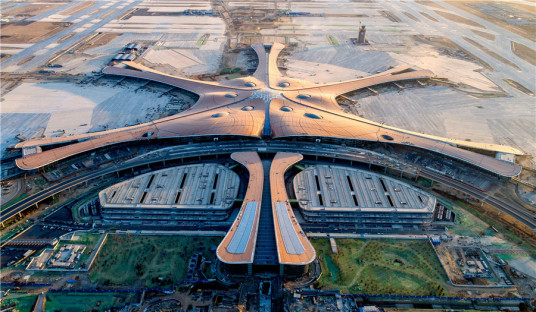Development plan to boost cooperation
 |
|
A bird's-eye view of Beijing Daxing International Airport, which is scheduled to open on Sept 30. [Photo by Li Xiaofan/For China Daily] |
Beijing-Tianjin-Hebei synergy set to sustain industrial growth in the region
The Beijing-Tianjin-Hebei integrated development plan, a part of China's national strategies, has achieved tangible results since its inception five years ago and helped the government to redistribute resources and industries in the capital to nearby regions for better growth, a senior official said.
"For environmental improvement, transportation and industrial cooperation, we have achieved rapid growth in the past years under the guidance of the integrated development plan," said Liu Bozheng, deputy head of the Beijing coordinated development office, at a conference in Tongzhou, where Beijing's municipal government and other agencies sitting in a sub-city complex are located.
President Xi Jinping called for the integrated and coordinated development of Beijing and the two neighboring areas during a symposium on Feb 26, 2014. On April 30, 2015, the Beijing-Tianjin-Hebei integrated development plan was approved, making it clear that the region will be built into a world-class city cluster with the capital as the core.
The three local governments have been working together since then on environmental protection including afforestation and combating air pollution.
In the past five years, Beijing and Hebei have built forests with a total area of 333 square kilometers and the capital's PM 2.5 levels, a measure of air pollution alerts, dipped to a record low last year.
The development plan had urged the construction of a mature transportation network in the region. Since then, it takes just one hour for rail travel between Beijing, Tianjin and Baoding in Hebei.
The Beijing Daxing International Airport, which is expected to become North China's air travel hub, is situated on the border of Beijing and Langfang, Hebei. The new airport, scheduled to be put into use later this year, will help to improve the efficiency of the airports' resources in Tianjin and Shijiazhuang, capital of Hebei.
The new airport's completion will help to boost the development of the four strategic areas in the region - like the Beijing New Airport Economic Zone.
According to the Beijing-Tianjin-Hebei Integrated Development Office, the other three are the Caofeidian Integrated Development Zone in Hebei, Tianjin Binhai New Area and the Zhangjiakou-Chengde Ecological Area, also in Hebei.
These zones will help boost economic growth in the region, and the three governments have carried out a series of cooperation projects in the past five years.
For instance, Beijing's Zhongguancun group has invested heavily in Tianjin in science and technology. Some high-end projects of Beijing companies such as automobile manufacturing have been shifted to Hebei.
According to data from the office, Beijing has invested 700 billion yuan ($105 billion) in Tianjin and Hebei for key industrial projects between 2015 and 2018.
Between Jan 16 and 18 this year, Xi inspected Tianjin and other cities in Hebei province and took stock of the reports on the integrated development in the region.
Xi also visited Beijing's sub-city center in Tongzhou on Jan 18 after the Beijing municipal government moved to the new administration buildings in the district.
Shi Jianxun, an economist with Tongji University said the integrated development of this region has entered a new phase. He said regional development will get new impetus, especially as the sub-city center will be key to Beijing in the new era.
Tianjin, a port city with a population of 14 million, and Hebei, a traditional industrial and transportation hub, will embrace their new development chances during the capital's resources and industries' redistribution, he said.
